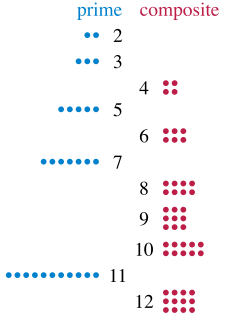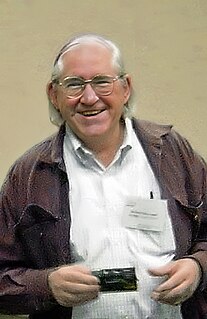
In mathematics, the Euclidean algorithm, or Euclid's algorithm, is an efficient method for computing the greatest common divisor (GCD) of two integers (numbers), the largest number that divides them both without a remainder. It is named after the ancient Greek mathematician Euclid, who first described it in his Elements . It is an example of an algorithm, a step-by-step procedure for performing a calculation according to well-defined rules, and is one of the oldest algorithms in common use. It can be used to reduce fractions to their simplest form, and is a part of many other number-theoretic and cryptographic calculations.
In mathematics, the factorial of a non-negative integer , denoted by , is the product of all positive integers less than or equal to . The factorial of also equals the product of with the next smaller factorial:
In mathematics, the greatest common divisor (GCD) of two or more integers, which are not all zero, is the largest positive integer that divides each of the integers. For two integers x, y, the greatest common divisor of x and y is denoted . For example, the GCD of 8 and 12 is 4, that is, .
In number theory, integer factorization is the decomposition of a composite number into a product of smaller integers. If these factors are further restricted to prime numbers, the process is called prime factorization.

A prime number is a natural number greater than 1 that is not a product of two smaller natural numbers. A natural number greater than 1 that is not prime is called a composite number. For example, 5 is prime because the only ways of writing it as a product, 1 × 5 or 5 × 1, involve 5 itself. However, 4 is composite because it is a product in which both numbers are smaller than 4. Primes are central in number theory because of the fundamental theorem of arithmetic: every natural number greater than 1 is either a prime itself or can be factorized as a product of primes that is unique up to their order.

Pell's equation, also called the Pell–Fermat equation, is any Diophantine equation of the form where n is a given positive nonsquare integer, and integer solutions are sought for x and y. In Cartesian coordinates, the equation is represented by a hyperbola; solutions occur wherever the curve passes through a point whose x and y coordinates are both integers, such as the trivial solution with x = 1 and y = 0. Joseph Louis Lagrange proved that, as long as n is not a perfect square, Pell's equation has infinitely many distinct integer solutions. These solutions may be used to accurately approximate the square root of n by rational numbers of the form x/y.
In mathematics, a square-free integer (or squarefree integer) is an integer which is divisible by no square number other than 1. That is, its prime factorization has exactly one factor for each prime that appears in it. For example, 10 = 2 ⋅ 5 is square-free, but 18 = 2 ⋅ 3 ⋅ 3 is not, because 18 is divisible by 9 = 32. The smallest positive square-free numbers are

In mathematics, factorization or factoring consists of writing a number or another mathematical object as a product of several factors, usually smaller or simpler objects of the same kind. For example, 3 × 5 is a factorization of the integer 15, and (x – 2)(x + 2) is a factorization of the polynomial x2 – 4.
In mathematics, an irreducible polynomial is, roughly speaking, a polynomial that cannot be factored into the product of two non-constant polynomials. The property of irreducibility depends on the nature of the coefficients that are accepted for the possible factors, that is, the field to which the coefficients of the polynomial and its possible factors are supposed to belong. For example, the polynomial x2 − 2 is a polynomial with integer coefficients, but, as every integer is also a real number, it is also a polynomial with real coefficients. It is irreducible if it is considered as a polynomial with integer coefficients, but it factors as if it is considered as a polynomial with real coefficients. One says that the polynomial x2 − 2 is irreducible over the integers but not over the reals.
Pollard's rho algorithm is an algorithm for integer factorization. It was invented by John Pollard in 1975. It uses only a small amount of space, and its expected running time is proportional to the square root of the size of the smallest prime factor of the composite number being factorized.
The quadratic sieve algorithm (QS) is an integer factorization algorithm and, in practice, the second fastest method known. It is still the fastest for integers under 100 decimal digits or so, and is considerably simpler than the number field sieve. It is a general-purpose factorization algorithm, meaning that its running time depends solely on the size of the integer to be factored, and not on special structure or properties. It was invented by Carl Pomerance in 1981 as an improvement to Schroeppel's linear sieve.
In number theory, Dixon's factorization method is a general-purpose integer factorization algorithm; it is the prototypical factor base method. Unlike for other factor base methods, its run-time bound comes with a rigorous proof that does not rely on conjectures about the smoothness properties of the values taken by polynomial.
In number theory, an n-smooth (or n-friable) number is an integer whose prime factors are all less than or equal to n. For example, a 7-smooth number is a number whose every prime factor is at most 7, so 49 = 72 and 15750 = 2 × 32 × 53 × 7 are both 7-smooth, while 11 and 702 = 2 × 33 × 13 are not 7-smooth. The term seems to have been coined by Leonard Adleman. Smooth numbers are especially important in cryptography, which relies on factorization of integers. The 2-smooth numbers are just the powers of 2, while 5-smooth numbers are known as regular numbers.
In computational number theory, the index calculus algorithm is a probabilistic algorithm for computing discrete logarithms. Dedicated to the discrete logarithm in where is a prime, index calculus leads to a family of algorithms adapted to finite fields and to some families of elliptic curves. The algorithm collects relations among the discrete logarithms of small primes, computes them by a linear algebra procedure and finally expresses the desired discrete logarithm with respect to the discrete logarithms of small primes.

Richard C. Schroeppel is an American mathematician born in Illinois. His research has included magic squares, elliptic curves, and cryptography. In 1964, Schroeppel won first place in the United States among over 225,000 high school students in the Annual High School Mathematics Examination, a contest sponsored by the Mathematical Association of America and the Society of Actuaries. In both 1966 and 1967, Schroeppel scored among the top 5 in the U.S. in the William Lowell Putnam Mathematical Competition. In 1973 he discovered that there are 275,305,224 normal magic squares of order 5. In 1998–1999 he designed the Hasty Pudding Cipher which was a candidate for the Advanced Encryption Standard, and he is one of the designers of the SANDstorm hash, a submission to the NIST SHA-3 competition.
Shanks's square forms factorization is a method for integer factorization devised by Daniel Shanks as an improvement on Fermat's factorization method.
In mathematics and computer science, a primality certificate or primality proof is a succinct, formal proof that a number is prime. Primality certificates allow the primality of a number to be rapidly checked without having to run an expensive or unreliable primality test. "Succinct" usually means that the proof should be at most polynomially larger than the number of digits in the number itself.
John David Brillhart is a mathematician, professor emeritus at the University of Arizona. He was born in 1930. He is known for his work in integer factorization, including the development of the continued fraction factorization method. He has been a principal participant in the Cunningham project. He, Lehmer and Selfridge made generalizations of the Pocklington primality test.
In mathematics, the Lucas–Lehmer–Riesel test is a primality test for numbers of the form N = k ⋅ 2n − 1, with k < 2n. The test was developed by Hans Riesel and it is based on the Lucas–Lehmer primality test. It is the fastest deterministic algorithm known for numbers of that form. For numbers of the form N = k ⋅ 2n + 1, either application of Proth's theorem or one of the deterministic proofs described in Brillhart-Lehmer-Selfridge 1975 are used.
In mathematics, the Pocklington–Lehmer primality test is a primality test devised by Henry Cabourn Pocklington and Derrick Henry Lehmer. The test uses a partial factorization of to prove that an integer is prime.






